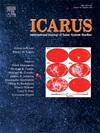New astrometric positions of Neptune and Triton in 2020–2024
IF 2.5
2区 物理与天体物理
Q2 ASTRONOMY & ASTROPHYSICS
引用次数: 0
Abstract
A total of 3836 astrometric positions of Neptune and its largest irregular satellite Triton were obtained in the period 2020–2024 by the 1.0 m telescopes at Yunnan Astronomical Observatory. Based on Gaia DR3 catalogue and the six-parameter plate model, 1918 new positions of Neptune and 1918 new positions of Triton were collected. For the observations of Neptune, with the comparison of DE441, the mean residuals are 30 mas and − 27 mas in right ascension and declination, the standard deviation of residuals are 28 mas and 33 mas in right ascension and declination. For the observations of Triton, with the comparison of the theoretical positions derived from Jacobson (2009) satellite orbit model and DE441, the mean residuals are 7 mas and − 14 mas in right ascension and declination, the standard deviation of residuals are 29 mas and 31 mas in right ascension and declination. Moreover, we also compared three recent orbit models of triton as well as three different planetary ephemerides of Neptune. These comparisons show that the differences among all the three planetary ephemerides are obvious.
2020-2024年海王星和海卫一的新天文测量位置
云南天文台1.0 m望远镜在2020-2024年间共观测到海王星及其最大的不规则卫星海卫一的3836个天文位置。基于Gaia DR3星表和六参数板块模型,收集了1918颗海王星和1918颗海卫一的新位置。对于海王星的观测,与DE441相比,赤经和赤纬的平均残差为30 mas和- 27 mas,赤经和赤纬的残差标准差为28 mas和33 mas。对于Triton的观测,将Jacobson(2009)卫星轨道模型与DE441得到的理论位置进行比较,赤经和赤纬的平均残差为7 mas和- 14 mas,赤经和赤纬的残差标准差为29 mas和31 mas。此外,我们还比较了海卫一最近的三种轨道模型以及海王星的三种不同的行星星历表。这些比较表明,这三种行星星历表之间的差异是明显的。
本文章由计算机程序翻译,如有差异,请以英文原文为准。
求助全文
约1分钟内获得全文
求助全文
来源期刊

Icarus
地学天文-天文与天体物理
CiteScore
6.30
自引率
18.80%
发文量
356
审稿时长
2-4 weeks
期刊介绍:
Icarus is devoted to the publication of original contributions in the field of Solar System studies. Manuscripts reporting the results of new research - observational, experimental, or theoretical - concerning the astronomy, geology, meteorology, physics, chemistry, biology, and other scientific aspects of our Solar System or extrasolar systems are welcome. The journal generally does not publish papers devoted exclusively to the Sun, the Earth, celestial mechanics, meteoritics, or astrophysics. Icarus does not publish papers that provide "improved" versions of Bode''s law, or other numerical relations, without a sound physical basis. Icarus does not publish meeting announcements or general notices. Reviews, historical papers, and manuscripts describing spacecraft instrumentation may be considered, but only with prior approval of the editor. An entire issue of the journal is occasionally devoted to a single subject, usually arising from a conference on the same topic. The language of publication is English. American or British usage is accepted, but not a mixture of these.
 求助内容:
求助内容: 应助结果提醒方式:
应助结果提醒方式:


